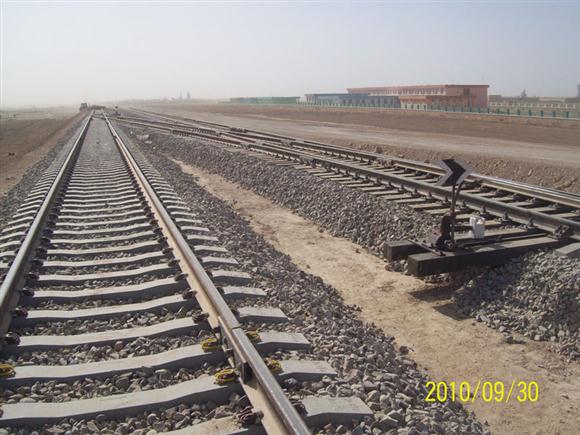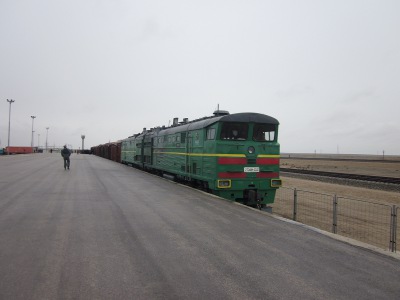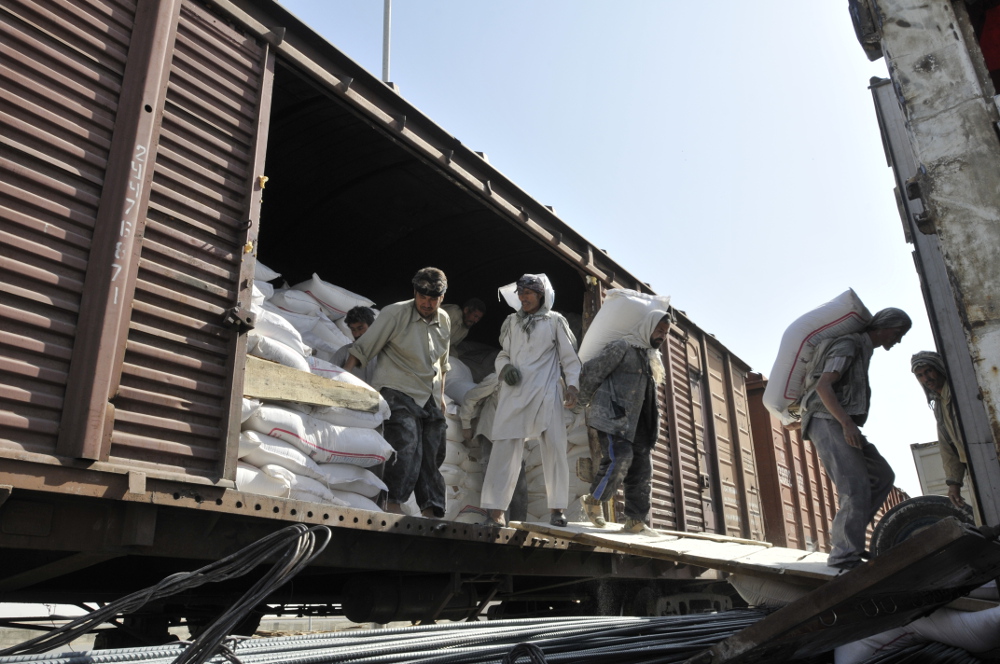Previous page: Hairatan to Mazar-i-Sharif railway
In 2011 Uzbekistan’s national railway O’zbekiston temir yo’llari (UTY) established a subsidiary called Sogdiana Trans to undertake its operations and maintenance activities in Afghanistan.

Railway terminal in Mazar-e-Sharif, 19 December 2013 (Photo: Jawad Jalali/Asian Development Bank, CC BY 2.0)
Sogdia is an historical name for a region which included parts of what is now in Uzbekistan.1
The Sogdiana Trans website is a bit sparse (there are no pictures… and as of July 2015 the site appears to have vanished altogether), and is in Russian, but includes a history of the company’s activities on the Hairatan to Mazar-i-Sharif railway project.
Some key points:2
- Afghanistan’s Ministry of Public Works and the Asian Development Bank (ADB) selected UTY for the design, build and commissioning contract in October 2009.
- The contract was signed by the Ministry of Public Works and UTY on 27 November 2009.
- Construction started on 22 January 2010.
- 12 March 2010 was set as the official start date of the project.
- The timetable for the 18-month turnkey contract included 12 months for the design and build phase, and 6 months for commissioning [presumably taking things to September 2011, if measured from the official March 2010 start date?]. UTY completed the work 4 months ahead of schedule [=May 2011?], and was awarded a US$4.5m bonus.

Meanwhile:
- On 8 February 2011 Sogdiana Trans was established as a subsidiary of UTY.3
- In 2011 the Ministry of Public Works and ADB began preparatory work for the launch of operations and maintenance on the new railway. ADB and the Afghan government jointly proposed appointing UTY as the operator, with its responsibilities to include mainline operations and shunting, as well as maintenance of the track, structures, signalling and telecoms, buildings and electricity networks.
- The operating contract was signed by the Ministry of Public works and Sogdiana Trans on 27 July 2011.4 This is reported to have been worth US$32m/year.5
- On 13 November 2011 UTY arrived in Afghanistan as the future operator, and began to study the technical condition of the new railway.
- 5 December 2011 was agreed as the start date for the first operational year.
- On 21 December 2011 a test train ran to Naibabad to demonstrate that the line was ready for use. The train comprised either 18 loaded wagons6 or seven empty wagons;7 8 reports vary.
Subsequently:
- On 3 February 2012 the first commercial freight train ran to Naibabad, with nine wagons carrying flour from Kazakhstan and three wagons of Siberian timber.

Later:
- On 29 October 20149 the Afghanistan Railway Authority invited expressions of interest in three contracts covering the operation, maintenance and management of the Hairatan to Mazar-i-Sharif railway. Responses from “experienced, high caliber and competent national and international rail operating, maintenance and management companies” were to be submitted to the Ministry of Public Works by 17:00 on 15 November 2014.
- On 15 March 201510 the Ministry of Public Works awarded UTY a new contract to operate and maintain the line.11 The contract runs for three years and will see UTY paid $19m/year to manage the line. UTY will pay taxes, and is to provide training for 50 Afghans each year. Until now the railway has only been used for imports, but the new contract should see the line used to carry a total of at least four million tonnes of Afghan goods for export.

Unloading flour at Rail Port 4, Niababad.
(Photo: Sgt 1st Class Timothy Lawn, 1st Theater Sustainment Command Public Affairs, US Army)
Next page: Herat to Mazar-i-Sharif and beyond
References
- Wikipedia’s article on Sogdia is probably as good a place as any to find more information about historical Sogdia. ↩
- Project Description Project Background, Sogdiana Trans ↩
- History of the project Sogdiana Trans ↩
- Project Sogdiana Trans ↩
- Uzbekistan extends contract on railway maintenance in Afghanistan, Demir Azizov, Trend, 21 March 2015 ↩
- Project Description Project Background, Sogdiana Trans ↩
- Hairatan-Mazar-e-Sharif railway opens, highlights country-to-country cooperation, CAREC ↩
- Afghan railway: First train runs on new line in north BBC News, 21 December 2011 ↩
- Afghanistan Railway Authority (AfRA) Ministry of Public Works ↩
- Upkeep matters: Afghanistan, Uzbekistan renew railway project agreement, Afghanistan Times, 15 March 2015 ↩
- Uzbekistan extends contract on railway maintenance in Afghanistan, Demir Azizov, Trend, 21 March 2015 ↩